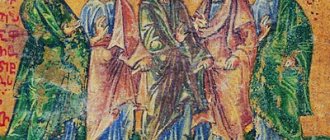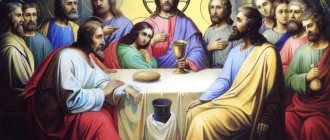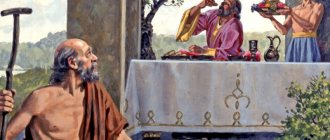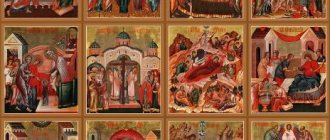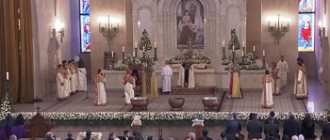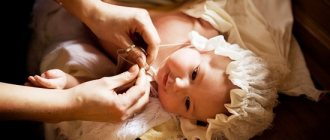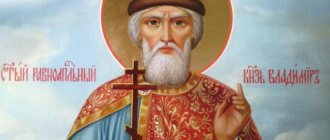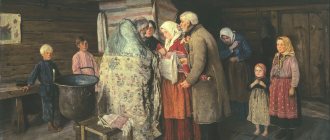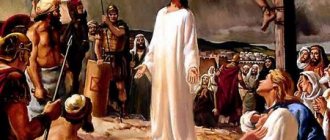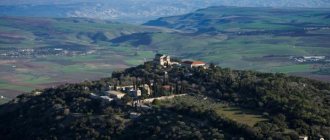Bible Questions and Answers
Published 06/20/2013
I have a question about the baptism of the 12 apostles. Were the first apostles of Jesus Christ re-baptized on the day of Pentecost or not?
Answer:
Why are Christians baptized?
The sign of the cross is made by Christians as a sign that we confess the Lord crucified on the cross. By making the sign of the cross at the beginning of every task, we testify that everything we do happens for the glory of the Crucified Christ.
The sign of the cross, i.e. The custom of drawing a cross on the body by placing fingers on the forehead, chest and shoulder (shoulders) is an ancient custom that appeared along with Christianity. The custom of Christians is to make the sign of the cross in the prayer of St. Basil the Great refers to the number of those that we have received from the apostolic tradition by succession.
IN AND. Surikov. Fragment of the painting “Boyaryna Morozova”
How to fold your fingers during the sign of the cross?
To make the sign of the cross, we fold the fingers of our right hand like this: “great and two small.” This signifies, according to the teachings of the Greater Catechism, the Holy Trinity: God the Father, God the Son and God the Holy Spirit, not three gods, but One God in the Trinity, divided by names and persons, but the Divinity is one. The Father is not begotten, and the Son is begotten and not created; The Holy Spirit is neither begotten nor created, but originated (Great Cat.). Having joined together two fingers (index and great-middle), we have them outstretched and slightly inclined - this forms the two natures of Christ: Divinity and humanity; With one (index) finger we signify the Divine, with the other (middle), slightly bent, we signify humanity; the inclination of the fingers is interpreted by the holy fathers as an image of the incarnation of the Son of God, who “bowed the heavens and came down to our earth for the sake of salvation.”
Having folded the fingers of the right hand in this way, we place two fingers on our forehead, i.e. forehead. By this we mean that “God the Father is the beginning of all Divinity, from Him the Son was born before the ages, and in the last times bowed down to the heavens, came down to earth and became man.” When we place our fingers on the stomach, we signify that in the womb of the Most Holy Theotokos, through the overshadowing of the Holy Spirit, there was a seedless conception of the Son of God; from her he was born and lived on earth with mankind, suffered in the flesh for our sins, was buried and on the third day was resurrected and raised from hell the righteous souls who were there. When we place our fingers on the right shoulder, it is interpreted as follows: first, that Christ ascended into heaven and is seated at the right hand of God the Father; second, that on the day of judgment the Lord will place the righteous at His right hand (right hand), and sinners at His left hand (left hand). The standing of sinners on the left hand also means the position of the hand when making the sign of the cross on the left shoulder (Great Catech., Chapter 2, sheets 5, 6).
Double finger
Baptism of the 12 Apostles of Jesus Christ
This is a very popular question. Unfortunately, the answer will not be clear. The Bible simply does not answer this question directly. So let me just share my opinion. First of all, you believe that the disciples of Christ (in your question we are talking about the Apostles) had already been baptized. The assumption seems reasonable given that the disciples baptized other disciples (John 4:1-2). So when were the disciples baptized for the forgiveness of sins and to receive the Holy Spirit (quoting Acts 2:38)? I say this for two reasons.
The first reason is found in Acts chapter 2. When the Bible tells of Peter's first preaching on the day of Pentecost in Acts 2, we also find the following: “the people were cut to the heart” and “those who accepted his word were baptized, and in all about three thousand people that day increased to the number of believers" (verses 37, 41). It is possible that a significant portion of the believers had already been baptized with the baptism of John before this point. And this passage implies, although it does not directly say, that these people were baptized into Christ on the day of Pentecost. If it can be said that some of the listeners of Peter's sermon were re-baptized, why not assume the same in the case of the Apostles.
In addition, we have an example found in the book of Acts 19:1-5, where we see the disciples who were baptized with the baptism of John, but knew nothing about the Holy Spirit. They also “crossed themselves” or were baptized again. All these things put together are the reason for my assumption that the first Apostles of Jesus Christ were re-baptized before the 3000 people were baptized on the day of Pentecost. However, remember that this is controversial, so don't treat this opinion as fact.
John Ochs
Where did double fingers come from?
The custom of folding fingers in this manner was adopted by us from the Greeks and was preserved by them unchanged from the time of the apostles. Scientists, prof. Kapterev and Golubinsky collected a whole series of evidence that in the 11th-12th centuries the Church knew only the double-finger formation. We also find double fingers in all ancient icon images (mosaics and frescoes of the 11th-14th centuries).
Savior Almighty. Andrey Rublev. Iconostasis of the Assumption Cathedral in Vladimir (1408)
Information about double fingers is also found in ancient Russian literature, including the works of St. Maxim the Greek and the famous book “Domostroy”.
Why not three-fingered?
Usually believers of other faiths, for example, New Believers, ask why Old Believers do not cross themselves with three fingers, like members of other Eastern churches.
On the left is the three-fingered sign; this sign of the cross was adopted by the New Believer tradition. On the right is two fingers, the Old Believers sign themselves with this sign of the cross
The following can be answered:
- Double-fingering was commanded to us by the apostles and fathers of the ancient Church, for which there is a lot of historical evidence. The three-fingered ritual is a newly invented ritual, the use of which has no historical justification;
- The keeping of two fingers is protected by a church oath, which is contained in the ancient rite of acceptance from heretics by Jacobite and the decrees of the Council of the Hundred Heads in 1551: “ If anyone does not bless with two fingers as Christ did, or does not imagine the sign of the cross, let him be damned ”;
- The two-fingered sign reflects the true dogma of the Christian Creed - the crucifixion and resurrection of Christ, as well as the two natures in Christ - human and Divine. Other types of the sign of the cross do not have such dogmatic content, but the three-fingered sign distorts this content, showing that the Trinity was crucified on the cross. And although the New Believers do not contain the doctrine of the crucifixion of the Trinity, St. the fathers categorically prohibited the use of signs and symbols that have heretical and non-Orthodox meaning. Thus, polemicizing with Catholics, the holy fathers also pointed out that the mere change in the creation of a species, the use of customs similar to heretical ones, is in itself a heresy. Ep. Nikolas of Methonsky wrote, in particular, about unleavened bread: “Whoever consumes unleavened bread is already suspected of communicating with these heresies because of some similarity.” The truth of the dogmatics of two fingers is recognized today, although not publicly, by various New Believer hierarchs and theologians. So oh. Andrey Kuraev in his book “Why the Orthodox are like this” points out: “I consider two-fingered to be a more accurate dogmatic symbol than three-fingered. After all, it was not the Trinity that was crucified, but “one of the Holy Trinity, the Son of God . ”
Why Orthodox people are baptized with three fingers and what Nikon’s reforms of the 17th century led to
Have you ever wondered why Orthodox people cross themselves with three fingers? At one time I was very interested in this question. And since I consider myself an Orthodox person, and such an important ritual cannot be a trifle, even though it may disappear from view due to routine, this topic has become important to me. Therefore, it was decided to get to the bottom of this.
The first thing that came to mind about triplets is a purely Orthodox symbol, which can mean the trinity of God - Father, Son and Holy Spirit, and the sign of the cross itself - sanctification by the Lord and renunciation of evil. Here, for example, is the interpretation taken from the Orthodox website azbyka.ru:
The sign of the cross is a bodily expression of Christian dogmas, a confession of the Christian faith in the Holy Trinity and the God-Man Jesus Christ, an expression of love and gratitude to God, protection from the action of fallen spirits. [1]
Further, in the process of searching, I came across a picture in which the exact same crossing of fingers as in the sign of the cross, but with a different name and meaning - the picture depicted a mudra! Mudra (Sanskrit: मुद्रा, mudrā, “seal, sign”) - in Hinduism and Buddhism - a symbolic, ritual arrangement of the hands, ritual sign language.
I became interested in comparing the meanings of this gesture in the traditions of Orthodoxy and Hinduism. The information that was found was, to put it mildly, very surprising. It turns out that the three-fingered connection of the tips of the thumb, index and middle fingers in Hinduism means “kubera mudra” or, in other words, “the mudra of wish fulfillment.” Kubera himself is considered the god of wealth, treasures and the treasurer of the Almighty in Hinduism; he personifies the harmony of spiritual and material wealth.
So, what was found in open sources on the Internet - a recipe from Kubera (or Ahriman):
Reference: The Supreme Archon, or he is also called “Archon of this world”, which is similar to “prince of this world”, is Ahriman... But in more ancient times, his name as the Supreme Archon sounded like Abraxas, as it is interpreted now - “the spirit of the cosmic whole , who, not being absolutely evil, remained in ignorance, mistaking himself for the absolute God." This legend can only be mistaken for a fairy tale by those who are ignorant of the knowledge and structure of the world. For the smart ones, this is a hint, a hint. [2]
“Use Kubera mudra to fulfill all your desires and goals. If we are talking about small desires, then visualization is not necessary, but to fulfill large ones it is necessary. Conduct meditation daily, mentally imagining your dream as having already come true. Do it for several days or even weeks in a row, while keeping your hands folded in mudra. Use Kubera mudra while chanting mantras.” [3]
The use of Kubera Mudra supposedly gives a person equanimity, confidence in achieving a goal, and accelerates the fulfillment of various desires. The important thing is not how long the mudra is practiced, but with what intensity.
What does a Hindu, Buddhist and Orthodox Christian think about and what does a Hindu, Buddhist and Orthodox Christian think about during ritual actions with crossing the fingers in this way? After all, it is at this moment that there are two different vectors. The first is the salvation of the Soul and asking the Creator only for this, the inner feeling of the need to be only with God and to be His son. The second is a request for something material. Who, if not Kubera or Ahriman, or Satan is responsible for the fulfillment of desires, who will hear such a request, and who will ultimately fulfill the request? The payment for this is extremely high, because in the first case it is eternity, Paradise, salvation of the soul and life with God, while in the second it is hell and, if we take Buddhism, subsequent reincarnation and prolongation of suffering.
On one of the sites I even found the following phrase: “I give the best and get in return what I need.” To paraphrase, in essence - “I give everything and at the same time receive something material, temporary.” If you remove the time factor, then I will not receive anything, but I will give everything - the salvation of my Soul. Some very dubious deal turns out...
This discovery prompted me to dig deeper and find out whether in the history of the Orthodox Church three fingers have always been used in the sign of the cross and what happened before.
Nikon's reforms
I won't beat around the bush for long. Baptism with three fingers was not always present; until the middle of the 17th century, people were baptized in what is now called - “in the Old Believer manner” - with two fingers.
If we compare two-fingered fingers with mudras, this is Prana Mudra or Mudra of Life. Its name completely speaks for itself. In some sources you can find that it serves to stabilize the flow of energy flows throughout the body, increase the level of vitality, activates the root chakra and increases vitality, and gives confidence in one’s own abilities. It is also good to practice it if fatigue has overcome and a person is exhausted. [5]
So, the attentive reader will again notice a certain substitution, a material desire for the body to feel good. Although we can often see on new and old icons of Jesus Christ, Angels or Holy Fathers with just such a hand sign, which in the east would definitely be called wise life.
Regarding the connection of the ring finger with the index finger, interesting information can be found in the AllatRa :
“Yes, this is a gesture of connecting the ring finger with the thumb as a symbol of the union of the power of God and the energy potential of man himself , and even from Jesus Christ himself as the Son of God - truly a real gesture of blessing humanity.”
***
“As for the position of the fingers... If the ring finger, according to meditative functions, symbolized spiritual vision, knowledge, superpowers, then the thumb is the energy potential of the power of the person himself . In particular, the thumb indicated that the chakran, approximately located in the lower abdomen, inside the pelvic girdle, between the bones of the coccyx and the pubic symphysis, was involved in meditation. Outwardly, it was conventionally depicted in diagrams of a person in the crotch area. But this is just conditional, because we are talking not about the physical, but about the energy body of a person.”
(A. Novykh, “AllatRa”)
Another interesting thing is that:troeperstie3
“At first, Christians were baptized with one finger , thereby emphasizing their faith in one God - as opposed to pagan polytheism. After the Ecumenical Council of Nicaea (325), which formulated the dogma of the unity of two natures in Christ, Christians began to cross themselves with two fingers . When Rus' was baptized into Orthodoxy, in Byzantium they were baptized with two more fingers, and this custom passed on to Rus'. Then, in the 11th century, in contrast to another heresy that denied the Trinity of God, it was prescribed to be baptized with three fingers (a symbol of the Trinity). But, due to the separation of Rus' from Byzantium, this custom was not introduced in Rus' until Nikon. The Old Believers, not knowing anything about the further development of church culture in Byzantium, stubbornly clung to two fingers.” [1]
I have never been able to find a mudra that corresponds to one finger. The closest meaning is bronchial mudra for those suffering from respiratory diseases, for those who experience internal loneliness, a feeling of isolation, sexual problems, and are sad. But these are only the external manifestations of this mudra; what it means in a deeper meaning, perhaps you, the reader, will be able to find and share your find in the comments to the article.
Further information is presented exclusively from the point of view of the analysis of historical events and is interesting only as the cause and consequence of events that have already occurred.
Returning to history, it must be said that in the years 1650-1660, Patriarch of All Rus' Nikon carried out the following church reforms:
- Large-scale “bookishness on the right” was expressed in the editing of the texts of the Holy Scriptures and liturgical books. This even led to changes in the wording of the Creed. The conjunction-contrast “a” was removed from the words about faith in the Son of God “born and not made”, they began to speak about the Kingdom of God in the future (“there will be no end”), and not in the present tense (“there will be no end”), The word “True” is excluded from the definition of the properties of the Holy Spirit. Many other innovations were also introduced into historical liturgical texts, for example, another letter was added to the name “Jesus” (under the title “Ic”) and it began to be written “Iesus” (under the title “Iis”).
- Including the concept of “servant of God” instead of a son.
- The two-fingered sign of the cross was replaced with a three-fingered one and the abolition of “throwings”, or small prostrations to the ground. In 1653, Nikon sent out a “memory” to all Moscow churches, which said: “It is not appropriate to do throwing on your knees in the church, but you should bow to your waist; I would also naturally cross myself with three fingers.”
- Instead of the eight-pointed cross, they began to use four-pointed and six-pointed ones.
- Nikon ordered religious processions to be carried out in the opposite direction (against the sun, not in the direction of salt).
- The exclamation “Hallelujah” during the service began to be pronounced not twice (special hallelujah), but three times (three-gut hallelujah).
- The sacrament of the Eucharist began to be celebrated not on seven prosphora, but on five, and the design of the seal on the prosphora was also changed. [4]
Traditional prosphora
Old Believer prosphora
It is necessary to say a few words about Nikon
Nikita Minin, the secular name of Patriarch Nikon, was born in 1605. His parents were peasants and it is said that he also had three brothers. His mother died soon after his birth, and his father remarried. Nikita's relationship with his stepmother did not work out. The story of Subdeacon Shusherin, who compiled the biography according to Nikon, says that she starved him, beat him and even tried to kill him [6]. The father sent his son to study literacy and the Holy Scriptures, he, in turn, turned out to be a capable student and soon went to the Makariev-Zheltovodsky Monastery to continue his studies. From this, one might say, his church path began.
Attracts attention to the fact that, having become the head of the brethren of the Novospassk monastery, he became part of an informal circle of clergy and secular persons, which Professor N.F. Kapterev called the circle “zealots of piety.” The main ideologists of this group were the confessor of Tsar Alexei Mikhailovich, archpriest of the Annunciation Cathedral Stefan Vonifatiev, boyar Fyodor Mikhailovich Rtishchev, as well as archpriest of the Kazan Cathedral John Neronov. The main task of the society was to revive religious and church life in the Moscow state, to spread enlightenment, and to improve the morality of both the population and the clergy.
Over time, Nikon, through his high-ranking associates, managed to get closer to the sovereign, moreover, he became his adviser not only on spiritual matters, but also on state affairs. As a result, on July 25, 1652, he was solemnly enthroned as the Patriarchs of Moscow and All-Russia. Interestingly, already during his enthronement Nikon forced the tsar to promise not to interfere in the affairs of the Church. The king and the people swore to “listen to him in everything, as a ruler and a shepherd and a noble father .
Further , as soon as the charismatic clergyman began his activities on the patriarchal throne, he emerged as an imperious, harsh and tough leader. It turned out that he did not need any companions at all. As a result, his former associates in society took up arms against him. [7] Such actions spoke eloquently of the arrogance of Nikon’s personality. And the struggle for educational and spiritual affairs, over time, took the shape of a struggle for power.
The result of Nikon’s activities:
On December 12, 1666, the third and final meeting of the Council on the Nikon case took place in the Annunciation Church of the Chudov Monastery.
The letter signed by all the bishops of the Russian Local Church of the Great Moscow Cathedral, as well as the hierarchs (patriarchs, metropolitans, archbishops, bishops) of the Greek local churches dated December 12, indicates the crimes because of which Nikon was expelled from the patriarchate and priesthood by the court of the local council of the Russian Church .
An interesting fact is that, despite the decision of the meeting, the reforms themselves did not suffer the same fate as Nikon. From this we can conclude that someone benefited from this and someone very cleverly manipulated this whole story to achieve their goals.
The consequences of reforms on people
“I don’t want to be a king, I want to live with you as a brother.”
(Stepan Timofeevich Razin - ataman of free people)
Many people were subjected to severe trials and even executions for their religious beliefs. Among them is the fairly well-known archpriest Avakuum, who, as it turns out, was a member of the “Circle of Devotees of Piety.” They also tortured and executed Boyarina Morozova and her like-minded women, who were tortured on the rack, trying to persuade them to betray the faith of the Old Believers, but they did not retreat a single step.
Many have probably heard about the Solovetsky Monastery, whose brethren refused to accept innovations. It was besieged by the royal regiments for two years. There is a legend about Solovki: “Whoever survived for several years among the elders admired the living in heaven and returned to the world invincible and immortal.” By the way, this monastery was visited by the well-known Cossack Stepan Timofeevich Razin twice before the tragic events: in 1652 and in 1661 [Edition: The Peasant War under the leadership of Stepan Razin. - M.: Publishing House of the USSR Academy of Sciences, 1954-1962.]
In 1677 and 1678, at the Small and Large Church Local Councils of the Russian Church, the blessed princess Anna Kashinskaya (in the schema, nun Sophia) was decanonized for the fact that the hand of the princess, who died in the 14th century, depicted two fingers, and her open relics lay in the city cathedral Kashin for public worship. She was declared not a saint, her relics were buried and her services were forbidden, leaving only funeral services, and the temple was renamed in honor of the princess.
Is it a coincidence that in 1667 an uprising began under the leadership of Stepan Razin and was it only because of the Council Code of 1649 and the complete enslavement of the peasants? Indeed, in addition to increasing pressure on the material sphere of human life, Nikon’s reforms affected the religious and spiritual values of the people, which were previously valued much higher than the first factor. By the way, some historians solved a very interesting puzzle in the riddle that was hidden behind the name “Stenka Razin”. If you wrap the surname you get “Ni Zar”, that is, “Not the Tsar”, but with the name it’s a little more complicated - we take the suffix and the rest of the word backwards, it turns out “Kanets”, that is, “The End”. It turns out - “Not the Tsar. End". Perhaps it was then, as they say, that the former state called Great Tartaria and its ataman of free people, hidden under the name Stepan Timofeevich Razin, fell into tartar.
You can write about all these personalities and events of those days for a long time, but these are separate topics for conversation...
Conclusions:
· The sign of the cross in Eastern traditions means kubera mudra, which serves to fulfill desires. At the same time, in the Old Believer traditions, for the sign of the cross they used, to put it in Eastern terms, prana mudra. It is important to understand what desires a modern Orthodox Christian has—material and temporary, or the desire to gain inner spiritual freedom? This will determine the entire subsequent outcome. · Despite the overthrow of Patriarch Nikon from the priesthood in 1666, the Great Moscow Council in 1667 approved his reforms, and everyone who did not accept the council’s decisions was anathematized as heretics and disobedient to the Church. This means that the new reforms were beneficial to someone and someone very cleverly managed those processes that are global in Orthodoxy (the sign of the cross, signs, prayers, interpretations, rituals, etc.) and led it to a schism. · Observing these historical processes, we see that any religious system is very closely intertwined with geopolitical processes and cannot be separated from external factors. During such events, Primordial Knowledge is lost and deliberately replaced, which leads people to misunderstanding the basic vital questions: “Who am I?”, “Where am I?” and “Where should I go?” But despite this, the people themselves have the opportunity to change the situation, everything depends on the dominant choice of each person!
From the book “AllatRa” :
“Yes, whatever one may say, it all starts with the material direction of a person’s consciousness. And if in society there is a loss or distortion of the essence and meaning of primordial Knowledge due to the intervention of the Animal mind, then this material bias will only worsen in the consciousness of future generations...
***
In the dissemination of spiritual Knowledge, there is always a temptation from the Animal nature in pride, likening oneself to a higher being, in the desire to appropriate this Knowledge for oneself, to interpret it in one’s own way, from one’s own mind in conversation with other people. This is how they are usually distorted from the Animal nature, replaced by material concepts and, as a result, the loss of primordial Knowledge. A person needs to understand that spiritual Knowledge is given for all people. Man is not God, not an angel, not a cherub, not the Holy Spirit. He is just a person, the same as all people, since his Soul is imprisoned in a multidimensional energy structure that belongs to the material world .”
I would like to express my gratitude to the ALLATRA Vesti team for their help in writing this article!
Author: Igor Subbotin
Sources:
1. https://azbyka.ru/krestnoe-znamenie 2. A. Novykh “Sensei-IV. Primordial Shambhala” 3. https://www.zdravamir.ru/index.php?option=com_content&view=article&id=117:-qq—-&catid=22:2010-12-24-10-02-51&Itemid=28 4. From the book: Old Believers in Russian culture. Philosophical and socio-legal aspects 5. https://mechtayte.ru/mudry-znachenija-palcev-opisanie/ 6. Materials for the “Chronicle of the life and literary activity of Patriarch Nikon”. - St. Petersburg: Dmitry Bulanin, 2003. - 520 p. 7. Circle of zealots of piety - article from the Great Soviet Encyclopedia.
